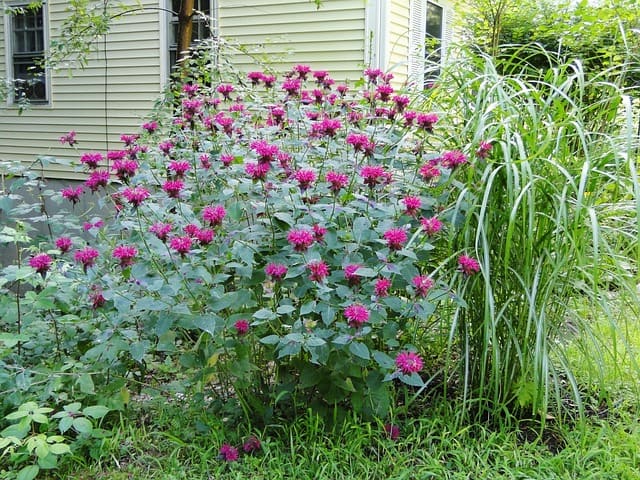Bee balm, also known as Monarda, is a popular flowering plant known for its vibrant blooms and minty fragrance. However, gardeners may encounter the issue of their bee balm leaves turning brown, which can be a cause for concern. Brown leaves can be a sign of several issues, including overwatering, underwatering, root rot, fungal diseases, and pests.
Understanding the causes of brown bee balm leaves can help gardeners diagnose and treat the issue effectively. Overwatering or underwatering can lead to root rot, which damages the roots and causes the leaves to turn brown and die.
Fungal diseases such as powdery mildew and gray leaf spot can also cause brown spots on the leaves, which can spread and potentially kill the plant. Pests such as spider mites and aphids can also cause damage to the leaves, causing them to turn brown or yellow.
Key Takeaways
- Brown bee balm leaves can be a sign of overwatering, underwatering, root rot, fungal diseases, or pests.
- Understanding the causes of brown bee balm leaves can help gardeners diagnose and treat the issue effectively.
- Proper watering, air circulation, pruning, and use of fungicides and resistant varieties can help prevent brown bee balm leaves.
See these other popular posts:
Understanding Bee Balm

Bee balm, also known as Monarda or wild bergamot, is a hardy perennial herb that is native to North America. It is a member of the mint family and is well-known for its fragrant, showy flowers that come in shades of pink, purple, red, and white. Bee balm is a popular choice for pollinator gardens due to its ability to attract bees, butterflies, and hummingbirds.
Bee balm is a relatively low-maintenance plant that can grow up to 4 feet tall and 3 feet wide. It prefers full sun to partial shade and well-draining soil. Bee balm is also drought-tolerant and can withstand occasional periods of dryness.
One of the most common issues that bee balm plants face is browning leaves. This can be caused by a variety of factors, including overwatering, underwatering, root rot, and powdery mildew. It is important to monitor the soil moisture levels and ensure that the plant is not sitting in water for extended periods of time.
Bee balm is also susceptible to fungal diseases such as powdery mildew, which can cause the leaves to turn yellow or brown. It is important to keep the plant well-ventilated and to remove any infected leaves to prevent the spread of the disease.
Bee Balm Varieties and Their Colors
Bee balm, also known as Monarda, is a popular garden plant that is loved for its showy, brightly colored flowers and its ability to attract pollinators like bees and butterflies. There are many different varieties of bee balm, each with its unique characteristics and colors.
Here are some of the most popular bee balm varieties and their colors:
- Jacob Cline: This variety has bright red flowers that are a favorite of hummingbirds.
- Marshall’s Delight: This variety has pink flowers that are a lighter shade than other pink varieties.
- Prairie Night: This variety has dark purple flowers that are almost black.
- Snow Queen: This variety has white flowers that are tinged with pink.
- Raspberry Wine: This variety has deep pink flowers that are a favorite of butterflies.
Bee balm flowers come in a range of colors, including red, white, purple, and pink. The flowers are typically tubular in shape and have a distinctive, spicy fragrance. The leaves of bee balm plants are also fragrant and can be used to make tea.
Bee balm plants are easy to grow and care for, and they thrive in full sun or partial shade. They prefer well-drained soil and should be watered regularly. Bee balm is susceptible to powdery mildew, a fungal disease that can cause the leaves to turn brown.
To prevent powdery mildew, make sure to provide good air circulation around the plants and avoid overhead watering.
Ideal Growing Conditions for Bee Balm
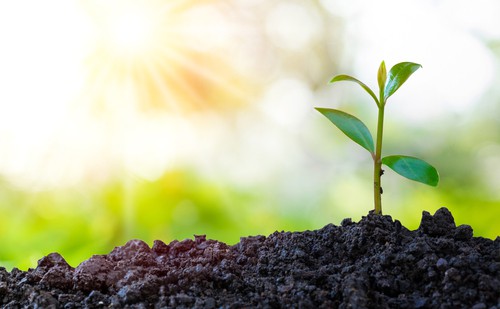
Bee balm, also known as Monarda, is a hardy and versatile plant that can thrive in a variety of growing conditions. However, to ensure that your bee balm is healthy and vibrant, it is important to provide it with the right growing conditions.
1. Light and Sun Exposure
Bee balm plants prefer full sun to partial shade, with at least six hours of direct sunlight per day. In areas with hot summers, partial shade can help prevent the leaves from scorching.
2. Hardiness Zones
Bee balm is a hardy plant that grows well in hardiness zones 3-9. It can tolerate a range of temperatures and climates, but it is important to choose a variety that is suitable for your region.
3. Soil Moisture
Bee balm prefers moist soil, but it can tolerate some drought. It is important to avoid overwatering, as this can lead to root rot and brown leaves. On the other hand, underwatering can cause the plant to dry out and lead to brown leaves as well.
4. Soil Type
Bee balm prefers well-draining soil that is rich in organic matter. It can tolerate a range of soil types, from sandy to clay, as long as the soil is well-draining.
5. Climate
Bee balm is a hardy plant that can tolerate a range of temperatures and climates. However, it may need some protection from strong winds, especially in areas with harsh winters.
Watering and Irrigation Practices

Proper watering practices are essential to prevent Bee Balm leaves from turning brown. Overwatering or underwatering can both cause stress to the plant, leading to brown leaves and wilting.
To prevent overwatering, it is important to ensure that the soil is well-draining. Bee Balm prefers soil that is moist but not waterlogged. If the soil is too wet, it can lead to root rot and other fungal infections, causing the leaves to turn brown and wilt.
On the other hand, if the soil is too dry, the plant can become dehydrated, leading to brown leaves and wilting. During dry periods, it is recommended to water the plant deeply, soaking the soil 6 to 8 inches deep. However, it is important not to water too frequently as this can lead to overwatering.
Applying mulch around the plant can help to retain moisture in the soil, preventing the plant from drying out too much. It is also important to consider the rainfall in the area when deciding whether or not to water the plant.
When irrigating Bee Balm, it is important to avoid getting the leaves and flowers wet. This can lead to fungal infections such as powdery mildew, causing the leaves to turn brown and wilt. Instead, water the soil at the base of the plant, keeping the leaves and flowers dry.
Common Diseases in Bee Balm Plants
Bee balm is a popular flowering plant that is known for attracting bees, butterflies, and hummingbirds. While it is a relatively low-maintenance plant, it can still be susceptible to a few common diseases. Here are some of the most common diseases that can affect bee balm plants:
1. Leaf Spot
Leaf spot is a bacterial disease that can affect bee balm plants. It appears as dark brown or black spots on the leaves and stems of the plant. The affected areas may also become distorted or fall off. Leaf spot is more common in wet conditions and can spread through water droplets or insects.
To prevent leaf spot, it is important to avoid overhead watering and to water the plant at the base. If leaf spot does occur, it is recommended to remove the affected leaves and treat the plant with a fungicide.
2. Powdery Mildew
Powdery mildew is a fungal disease that can affect many different types of plants, including bee balm. It appears as a white or gray powdery coating on the leaves, stems, and flowers of the plant. Powdery mildew can cause defoliation and reduce the plant’s overall health and vigor.
To prevent powdery mildew, it is important to avoid overcrowding plants and to provide good air circulation. If powdery mildew does occur, it is recommended to remove the affected leaves and treat the plant with a fungicide.
3. Root Rot
Root rot is a common problem in bee balm plants that can be caused by overwatering or poor drainage. It appears as blackened and mushy roots and can cause the plant to wilt and die.
To prevent root rot, it is important to provide well-draining soil and to avoid overwatering the plant. If root rot does occur, it is recommended to remove the affected roots and repot the plant in fresh, sterile soil.
4. Rust
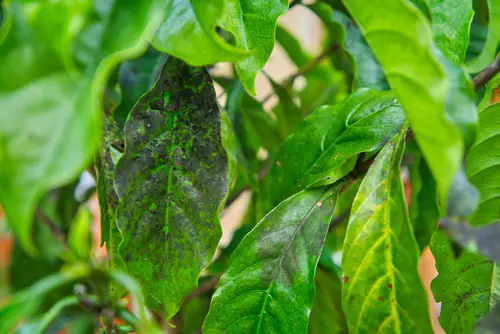
Rust is a fungal disease that can affect bee balm plants. It appears as orange or brown spots on the leaves and stems of the plant and can cause defoliation. Rust is more common in humid conditions and can be spread through water droplets or insects.
To prevent rust, it is important to avoid overhead watering and to water the plant at the base. If rust does occur, it is recommended to remove the affected leaves and treat the plant with a fungicide.
5. Gray Mold Spots
Gray mold spots are a fungal disease that can affect bee balm plants. It appears as gray or brown spots on the leaves and stems of the plant and can cause defoliation. Gray mold spots are more common in humid conditions and can be spread through water droplets or insects.
To prevent gray mold spots, it is important to avoid overhead watering and to water the plant at the base. If gray mold spots do occur, it is recommended to remove the affected leaves and treat the plant with a fungicide.
Pests That Affect Bee Balm
Bee balm is susceptible to a variety of pests that can cause its leaves to turn brown. Here are some of the most common pests that affect bee balm:
1. Aphids
Aphids are small, soft-bodied insects that suck the sap from the leaves and stems of bee balm plants. They reproduce rapidly and can quickly infest a plant, causing the leaves to curl and turn brown.
To control aphids, you can use insecticidal soap or neem oil. You can also introduce natural predators like ladybugs or lacewings to your garden, as they feed on aphids.
2. Spider Mites
Spider mites are tiny arachnids that feed on the sap of bee balm leaves. They are difficult to see with the naked eye, but you may notice a fine webbing on the plant. Spider mites can cause the leaves to turn yellow or brown and eventually fall off.
To control spider mites, you can use insecticidal soap or neem oil. You can also increase the humidity around the plant by misting it with water.
3. Ants
Ants are attracted to bee balm because of the sweet nectar it produces. While ants themselves don’t harm the plant, they can protect other pests like aphids from natural predators. To control ants, you can use a sticky barrier around the base of the plant or sprinkle diatomaceous earth around it.
You can also remove any sources of food or water that may be attracting the ants.
4. Other Pests
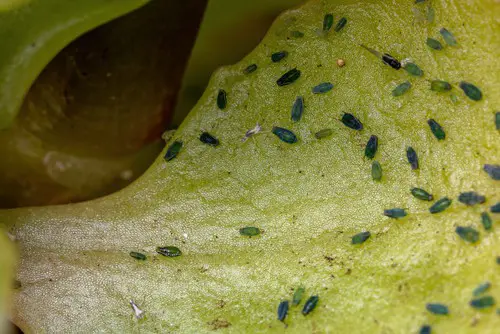
Other pests that can affect bee balm include thrips, whiteflies, and leafhoppers. Thrips and whiteflies are small, winged insects that feed on the sap of the plant. They can cause the leaves to turn yellow or brown and may also transmit plant diseases. Leafhoppers are small, wedge-shaped insects that feed on the sap of the plant.
They can cause the leaves to turn yellow or brown and may also transmit plant diseases. To control these pests, you can use insecticidal soap or neem oil. You can also introduce natural predators like ladybugs or lacewings to your garden, as they feed on these pests.
Signs of Nutrient Deficiency
Bee balm leaves turning brown is a sign of nutrient deficiency. When a plant lacks nutrients, it cannot perform its functions properly, leading to various symptoms. Nutrient deficiency can be caused by many factors, including poor soil quality, over-fertilization, or under-fertilization.
One of the most common nutrient deficiencies in bee balm is magnesium deficiency. Magnesium is an essential nutrient that is required for the plant’s growth and development. Without enough magnesium, the leaves will start to yellow and eventually turn brown. Magnesium deficiency can also cause the lower leaves to die off first.
Another sign of nutrient deficiency is yellowing leaves. When the plant lacks essential nutrients such as nitrogen, sulfur, or iron, the leaves will start to turn yellow. Nitrogen is essential for plant growth and development, and a lack of it can cause the leaves to become pale and yellow.
In addition to yellowing leaves, a lack of nutrients can cause the lower leaves to turn brown. This is because the plant will prioritize nutrient allocation to the newer growth, leaving the lower leaves to wither and die.
It is important to note that nutrient deficiency can be easily misdiagnosed as a disease or pest problem. Therefore, it is important to properly identify the symptoms and take appropriate action. A soil test can help determine which nutrients are lacking in the soil and help guide fertilization efforts.
Proper Air Circulation and Spacing
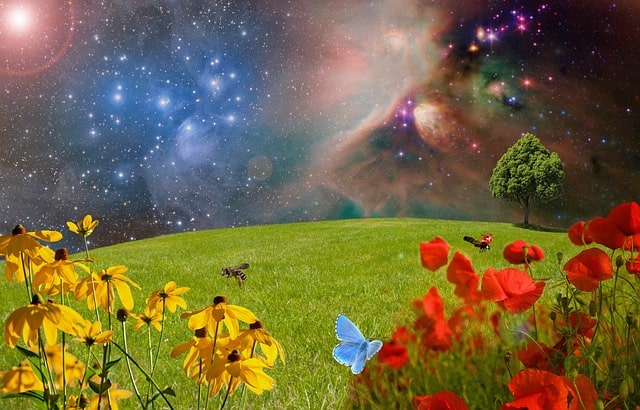
Proper air circulation is crucial for the health of Bee Balm plants. Overcrowding and lack of airflow can lead to a host of problems, including brown leaves. When Bee Balm plants are too close together, they can block each other’s access to light and air. This can create a humid microclimate that encourages fungal growth and disease.
To prevent overcrowding, Bee Balm plants should be spaced at least 18 to 24 inches apart. This allows for adequate airflow and reduces the likelihood of disease. In addition to proper spacing, regular pruning can help promote air circulation and prevent overgrowth.
It’s important to note that Bee Balm plants can grow quite tall, so it’s essential to provide enough space for their vertical growth as well. If Bee Balm plants are too close together, they may compete for resources like water and nutrients, leading to stress and brown leaves.
When planting Bee Balm, consider the mature size of the plant and plan accordingly. If space is limited, consider planting in containers or raised beds to ensure adequate airflow and prevent overcrowding.
Importance of Pruning and Deadheading
Pruning and deadheading are essential practices for maintaining the health and beauty of bee balm plants. These practices help to promote vigorous growth, prevent disease, and encourage the production of more flowers. In this section, we will discuss the importance of pruning and deadheading bee balm plants.
Pruning
Pruning is the process of removing dead, damaged, or diseased stems and leaves from the plant. It is also used to shape the plant and encourage new growth. Pruning should be done in the early spring before new growth begins.
When pruning bee balm, it is important to use clean, sharp tools to prevent the spread of disease. Cut the stems back to just above a healthy leaf node or bud. This will encourage new growth and prevent the plant from becoming too leggy.
Deadheading
Deadheading is the process of removing spent flowers from the plant. This practice helps to promote the production of more flowers and prevents the plant from going to seed. Deadheading should be done regularly throughout the growing season.
To deadhead bee balm, simply cut off the spent flower head just above the next healthy leaf node. This will encourage the plant to produce more flowers and prevent it from becoming too leggy.
Dividing
Dividing is the process of separating a mature plant into smaller sections and replanting them. This is done to rejuvenate the plant and prevent it from becoming too crowded. Bee balm should be divided every 3-4 years in the early spring.
To divide bee balm, dig up the entire plant and separate it into smaller sections using a clean, sharp knife or garden spade. Replant the sections in well-draining soil and water thoroughly.
Use of Fertilizers and Mulch
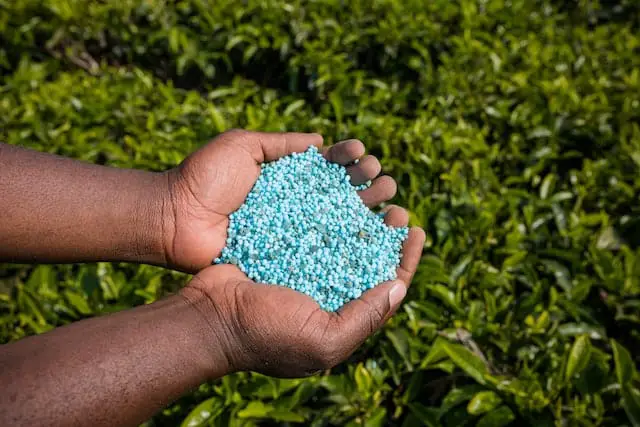
Bee balm plants require adequate nutrients to grow healthy and produce vibrant flowers. Fertilizers and mulch can provide these nutrients and help retain soil moisture.
Nitrogen
Nitrogen is an essential nutrient for plant growth and is commonly found in fertilizers. However, too much nitrogen can cause leaf burn and lead to brown leaves on bee balm plants. It is important to use a balanced fertilizer that contains equal amounts of nitrogen, phosphorus, and potassium.
Applying too much fertilizer can also result in excessive growth and reduce the plant’s ability to produce flowers.
Organic Fertilizer
Organic fertilizers are a great alternative to synthetic fertilizers as they release nutrients slowly and improve soil health. Compost, aged manure, and fish emulsion are excellent sources of organic fertilizer for bee balm plants. When applying organic fertilizer, it is important to follow the manufacturer’s instructions and avoid over-fertilizing.
Mulch
Mulch helps retain soil moisture, suppress weeds, and regulate soil temperature. Organic mulch, such as shredded leaves, bark, or straw, can also provide nutrients as it decomposes. Applying a layer of mulch around the base of the bee balm plant can help prevent moisture loss and reduce stress on the plant during hot and dry weather conditions.
Heat and Light Impact on Bee Balm
Bee balm plants are susceptible to damage from excessive heat and direct sunlight. When exposed to high temperatures and intense light, the leaves of the plant may turn brown and wilt. This is because bee balm plants are adapted to grow in partial shade and prefer cooler temperatures.
Direct sunlight can also impact the plant’s ability to photosynthesize, which can further weaken the plant. Bee balm plants require a certain amount of light to produce energy through photosynthesis, but too much light can cause damage to the plant’s chlorophyll and other pigments.
To prevent damage from heat and light, bee balm plants should be planted in a location that receives partial shade and is protected from the intense afternoon sun. If the plant is already damaged, it can be pruned to remove the affected leaves and encourage new growth.
In addition to providing shade, it is important to ensure that bee balm plants receive adequate water during periods of high heat and dry weather. This can help prevent the leaves from drying out and turning brown.
Resistant Varieties and Propagation

Bee balm plants can be propagated by division or seeds. Division is usually done in early spring or fall, while seeds can be sown in spring. Bee balm plants can also be propagated by stem cuttings taken in late spring or early summer.
When selecting bee balm varieties, it is important to choose those that are resistant to common diseases and pests.
Varieties that possess good to excellent resistance to powdery mildew include ‘Marshall’s Delight’ (bright pink flowers), ‘Jacob Cline’ (deep red flowers), Grand Marshall™ (fuschia-purple flowers), and ‘Raspberry Wine’ (wine red flowers) 1. These varieties are also known for their attractive flowers and fragrance.
Propagation of resistant bee balm varieties is a great way to ensure a healthy and disease-free garden. When propagating bee balm, it is important to use well-draining soil and to keep the soil consistently moist until the plants become established.
Bee balm plants can be planted in containers, making them a great choice for those with limited garden space. Smaller, more compact varieties of bee balm make for great container plants.
When planting bee balm in a container, make sure the container has drainage holes and is 5 gallons or more depending on the size of the bee balm variety and if any other plants are being planted in the same container 2.
Addressing Stunted Growth
When a Bee Balm plant experiences stunted growth, it can be a sign of a variety of issues. One possible cause is that the plant is not receiving enough sunlight.
Bee Balms require at least six hours of direct sunlight each day, so if the plant is in a shady spot, it may not be getting enough light. In this case, moving the plant to a sunnier location can help address the stunted growth.
Another possible cause of stunted growth is root rot. This can occur when the Bee Balm is planted too deeply in the soil, or if it is overwatered. To check for root rot, one can gently lift the plant with a shovel or trowel to see if the root ball is even with the ground.
If the plant is planted too deeply, it can be carefully lifted and replanted at the appropriate depth. If the plant is suffering from overwatering, reducing the amount of water given to the plant can help it recover.
Finally, stunted growth can also be a sign of nutrient deficiencies. Bee Balms require regular fertilization to thrive, and a lack of nutrients can cause stunted growth. Applying a balanced fertilizer can help address this issue.
Role of Gardeners and Extension Services
Gardeners play an important role in maintaining the health and beauty of their gardens, including their perennials such as bee balm. It is their responsibility to monitor their plants regularly for any signs of distress or disease, and take appropriate action to address the issue.
Extension services can also be a valuable resource for gardeners. These services provide information and resources to help gardeners identify and treat plant diseases, including those that affect bee balm. They can also offer advice on best practices for planting and maintaining perennials to help prevent future issues.
When dealing with bee balm leaves turning brown, gardeners should first identify the cause of the issue. This may involve examining the leaves for signs of disease or pest infestation, or checking the soil to ensure it is not too wet or dry. Once the cause has been identified, appropriate steps can be taken to address the issue.
Extension services can provide guidance on the best course of action, which may include pruning affected leaves, applying fungicides or pesticides, or adjusting watering or soil conditions. They can also offer advice on preventative measures to help avoid future issues, such as planting bee balm in well-draining soil and providing adequate air circulation.
Use of Fungicides
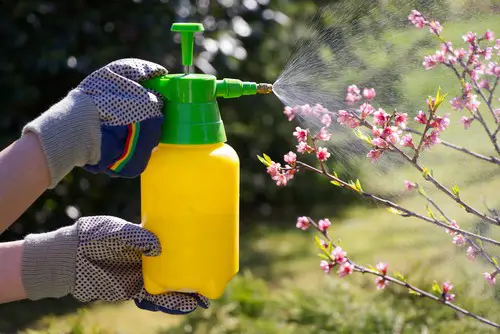
When it comes to treating bee balm leaves that have turned brown due to fungal diseases like powdery mildew, the use of fungicides can be an effective solution. Fungicides are chemical or biological agents that can help prevent or control the growth of fungi on plants.
Fungicides work by either killing the fungi or preventing their growth and reproduction. They can be applied as a spray or dust, and are available in various forms such as liquids, granules, and powders.
Before using a fungicide, it is important to identify the specific fungal disease affecting the bee balm plant. This can be done by examining the leaves for symptoms such as discoloration, spots, or powdery growth. Once the disease is identified, the appropriate fungicide can be selected.
There are many different types of fungicides available, each with its own mode of action and effectiveness against specific fungal diseases. Some common fungicides used to treat bee balm include:
- Sulfur-based fungicides: These fungicides work by inhibiting the growth of fungal spores and preventing their germination. They are effective against powdery mildew and other fungal diseases.
- Copper-based fungicides: These fungicides work by damaging the fungal cell membranes and preventing their growth and reproduction. They are effective against a wide range of fungal diseases.
- Neem oil: This is a natural fungicide that works by disrupting the life cycle of the fungus and preventing its growth and reproduction. It is effective against powdery mildew and other fungal diseases.
It is important to follow the instructions on the fungicide label carefully when applying it to the bee balm plant. Overuse or improper use of fungicides can lead to plant damage or resistance to the fungicide.
In addition to using fungicides, it is also important to practice good plant care to prevent fungal diseases from occurring. This includes proper watering, fertilization, and pruning, as well as removing any infected plant material to prevent the spread of disease.
Bee Balm Blooming and Flowers
Bee balm is known for its beautiful blooms that attract pollinators like bees, butterflies, and hummingbirds. The flowers of bee balm are tubular in shape and come in shades of pink, red, and purple. They bloom in mid to late summer and can last for several weeks.
The tubular petals of bee balm flowers are a unique feature that make them attractive to hummingbirds. The birds can easily insert their long beaks into the tubes to reach the nectar inside. The flowers also have a pleasant fragrance that adds to their appeal.
Bee balm plants are prolific bloomers and can produce many flowers on a single stem. Deadheading spent blooms can encourage the plant to produce more flowers. It is important to remove the flowers as soon as they start to fade to prevent the plant from going to seed too early.
In addition to their beauty, bee balm flowers are also used in herbal remedies. The leaves and flowers contain essential oils that have antiseptic and anti-inflammatory properties. They are often used to make teas and infusions that can help with digestive issues, colds, and sore throats.
Invasive Nature of Bee Balm

Bee balm, also known as Monarda, is a popular flowering plant that is native to North America. It is a member of the mint family and is known for its fragrant leaves and attractive flowers. However, despite its popularity, bee balm is also known for its invasive nature.
Bee balm can spread quickly and easily, especially in moist and fertile soil. Its seeds can be carried by the wind or by animals, and it can also spread through underground rhizomes. Once established, bee balm can be difficult to control and can quickly take over an area.
Invasive plants like bee balm can have a negative impact on the environment. They can outcompete native plants for resources, reducing biodiversity and altering ecosystems. They can also alter soil chemistry and nutrient cycling, which can have a ripple effect on other organisms in the ecosystem.
It is important to be aware of the potential invasive nature of bee balm and to take steps to control its spread. This can include regularly removing spent flowers and stems to prevent seed production, as well as digging up and removing any plants that have spread beyond their intended area.
While bee balm can be a beautiful addition to a garden or landscape, it is important to be mindful of its potential to become invasive and to take steps to prevent its spread. By being proactive in controlling its growth, we can help protect the natural environment and preserve native plant communities.
Frequently Asked Questions
What causes bee balm leaves to turn brown?
Bee balm leaves can turn brown due to various reasons, including fungal diseases, insect infestations, improper watering, and environmental stress. Powdery mildew, a common fungal disease, can cause the leaves to turn brown and develop black stains on the stems.
Insect infestations, such as spider mites, can also cause the leaves to turn brown. Overwatering or underwatering can lead to root rot, which can cause the leaves to turn brown and wilt.
How can I prevent bee balm leaves from turning brown?
To prevent bee balm leaves from turning brown, it is important to provide the plant with proper care. This includes planting the bee balm in a well-draining soil, watering the plant at the base to avoid getting the leaves and flowers wet, and providing good air circulation around the plant. Regularly removing dead or damaged leaves and flowers can also help prevent the spread of fungal diseases.
Are there any natural remedies for bee balm leaves turning brown?
There are several natural remedies that can help prevent and treat bee balm leaves turning brown. One of the most effective methods is to use natural fungicides, such as neem oil or baking soda, to treat fungal diseases.
Additionally, introducing beneficial insects, such as ladybugs or lacewings, can help control insect infestations. Applying compost or organic fertilizers can also help improve the plant’s overall health and resistance to diseases.
What is the best way to treat bee balm leaves that are turning brown?
The best way to treat bee balm leaves that are turning brown depends on the underlying cause. If the brown leaves are due to fungal diseases, using natural fungicides or removing the affected leaves can help prevent the spread of the disease.
Insect infestations can be controlled by introducing beneficial insects or using natural insecticides. Proper watering and fertilization can also help revive the plant and prevent further leaf browning.
Can bee balm leaves turning brown be a sign of a larger problem?
Bee balm leaves turning brown can be a sign of a larger problem, such as environmental stress or a more severe fungal or bacterial disease. It is important to monitor the plant closely and take appropriate measures to prevent the spread of the disease. If the problem persists, it may be necessary to consult a professional gardener or horticulturist for further advice.
Is there a way to revive bee balm leaves that have turned brown?
Reviving bee balm leaves that have turned brown depends on the underlying cause. If the brown leaves are due to improper watering or fertilization, adjusting the care regimen can help revive the plant. If the brown leaves are due to fungal diseases or insect infestations, using natural remedies or removing the affected leaves can help prevent further damage and revive the plant’s health.

Hey, I’m Lisa and I’ve been an avid gardener for over 30 years. I love writing, talking and living in the garden! Feel free to connect with me on my socials below

